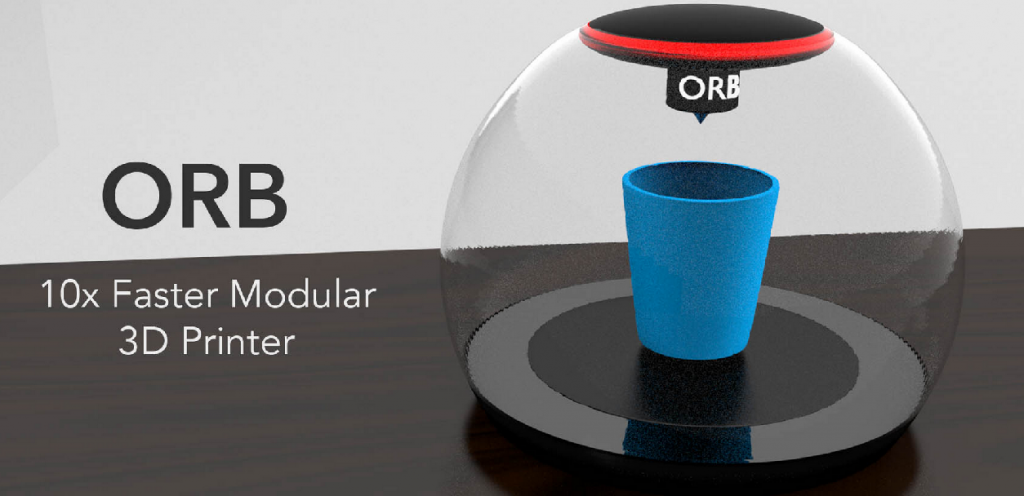15-Year-Old Unveils ORB 3D Printer & New Print Code — 10 Times Faster Than Traditional Machines
When it comes to 3D printing, speed is one of the areas in which we would all love to see the most improvement. After all, who wants to wait hours for a fist-sized object to be fabricated? In a world where things are taking place at an ever quicker pace, the lack of speed within the 3D printing process is certainly holding the technology back.
Over the last year we have heard several claims by the leaders within the industry that their forthcoming 3D printers will in fact be much faster. HP claims that they will have a new “ten times faster” Multi Jet Fusion technology available in 2016, while 3D Systems is working hard on a machine they claim will be 50 times faster than current printers on the market today. With that said, little is being done within the consumer market, particularly for FFF/FDM machines. These printers seem to have hit a major speed barrier unless the entire printing process is re-imagined.
That’s just what one 15-year-old teenager named Thomas Suarez is trying to do. We did a story on Suarez back in July when he announced that he would soon be unveiling a desktop 3D printer capable of printing at speeds which are 10 times greater than current technologies available today. As we mentioned in July, Suarez is not your typical 15 year old. He has been an app developer for years, and even gave a TED talk at the tender age of 12.
Today Suarez’s company, CarrotCorp, has officially unveiled their high-speed machine, and although general specifications have yet to be revealed, the ORB 3D Printer seems to be quite revolutionary.
The ORB uses several technologies new to the industry. These include a modular setup, allowing for customization and the rapid switching of particular components. It utilizes a spinning disc architexture, similar to that of a record player. The platform rotates rapidly, thus translating into print speeds which are 10 times that of your typical FFF/FDM 3D printer. Additionally, the ORB printer will be able to use special magnetically enhanced filaments containing specks of metal, which enable it to heat up, melt, and extrude much faster than filaments you may be used to. This, combined with a new heating process which stacks several heating elements on top of one another with a small air gap in between, should equate to the ability to extrude large quantities of molten plastic within a short time frame.
The modular system is part of an open development kit that CarrotCorp will soon be making available. This means that custom modules will be able to be created and used for the machine. Each module will handle a different print function. One module is used for extrusion, another for disc rotation, and so on. Each print instruction is then transmitted to the particular module which requires it.
As for print instructions, Suarez has developed his own type of code. The ORB printer will not use G-code, instead relying on ORB Print Code, a human-readable code which can be understood by practically anyone. Below is a short example of what this code will look like:
rpm 60;
home all;
heat extruder 230;
slide 0;
e;
spin 100;
r;
slide 20;
e;
spin 100;
r;
slide 40;
e;
spin 100;
r;
slide 60;
e;
spin 100;
r;
slide 100;
e;
spin 100;
r;
end;
The printer itself is shaped almost like a round fish bowl, and provides a full 360-degree viewing angle of the object being printed, even though the build platform is fully enclosed. Suarez and his company plan to launch a crowdfunding campaign in order to raise the necessary funding to mass produce this incredible new 3D printer in the coming weeks. Those interested can sign up on the company’s webpage in order to be notified of the forthcoming campaign. We will have to wait until then, it seems, before a price for the ORB is announced.
Please feel free to discuss the technology behind this new printer, as well as your thoughts on its potential, in the ORB 3D Printer forum thread on 3DPB.com. Below you will find a teaser video for this machine, released last year.
Subscribe to Our Email Newsletter
Stay up-to-date on all the latest news from the 3D printing industry and receive information and offers from third party vendors.
Print Services
You May Also Like
New Business: Temporary, Migratory, & Modular 3D Printed Architecture
If we look at potentially emerging 3D printing businesses, then architecture has not been fully explored. Yes, there is a lot of house 3D printing going on worldwide. From deployable...
3D Printing News Briefs, April 19, 2025: Material Extrusion Standard, Metal Powder, & More
In today’s 3D Printing News Briefs, we’re covering a proposed standard for material extrusion, before moving on to business and metal powder. We’ll end with a commercial store’s robotic 3D...
Japan Unveils World’s First 3D Printed Train Station
Japan is now home to what we believe is the world’s first train station built with 3D printing technology. Located in Arida City, just south of Osaka, the new Hatsushima...
restor3d Raises $38M to Expand 3D Printed Orthopedic Implants
Backed by $38 million in new funding, restor3d is pushing ahead with the launch of four personalized implant lines, set to roll out in 2025 and 2026. This latest venture...




























